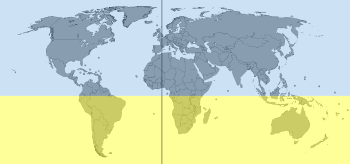Southern Hemisphere
The southern hemisphere - or southern hemisphere, southern hemisphere (from ancient Greek ἥμισυς hémisys, German 'halb' and σφαῖρα sfaira 'sphere') or southern hemisphere - is the part of the Earth located south of the equator. The latitude has a negative sign or the signature S. The southern hemisphere is the counterpart of the northern hemisphere.
In the southern hemisphere, astronomical summer lasts from December 21/22 to March 20/21 and winter from June 21 to September 22/23. South of the Tropic of Capricorn, the highest position of the sun always remains in the north, below the zenith. The geometry of the moon's phases also reverses from the northern hemisphere in observation. The astronomical counterpart to the southern hemisphere of the Earth is the southern starry sky in the celestial sphere.
The southern hemisphere has considerably more water area than land area and thus a greater dominance of water area than the northern hemisphere, since it lies in large parts in the water hemisphere. Land area is about 19% and water area is about 81%. Only about 10% of the people live in the southern hemisphere. The main land parts are the continents of Antarctica and Australia - the smallest continent on Earth - most of South America, the smaller part of Africa, and almost all of the Malay Archipelago. The oceans are the Southern Ocean, about half of the Pacific and Atlantic Oceans, and most of the Indian Ocean.
Due to the Coriolis force, low-pressure areas and also, for example, hurricanes rotate clockwise in the southern hemisphere according to the baric wind law.
The center of the southern hemisphere and the southern polar region is the geographic south pole - the southern intersection of the Earth's axis with the Earth's surface. The Antarctic magnetic pole is currently located just outside the Arctic Circle in the sea. The aurora in the southern hemisphere is called the aurora australis, or southern lights.
The most widely spoken language in the southern hemisphere is Portuguese. It is followed by Spanish and Javanese.

Southern Hemisphere

Distribution of the continents on both sides of the equator and the prime meridian (without Antarctica). Part of the southern hemisphere highlighted in yellow
See also
- Antarctic Oscillation
- Western and Eastern Hemisphere
Search within the encyclopedia